2007 VOLKSWAGEN GOLF PLUS belt
[x] Cancel search: beltPage 117 of 541
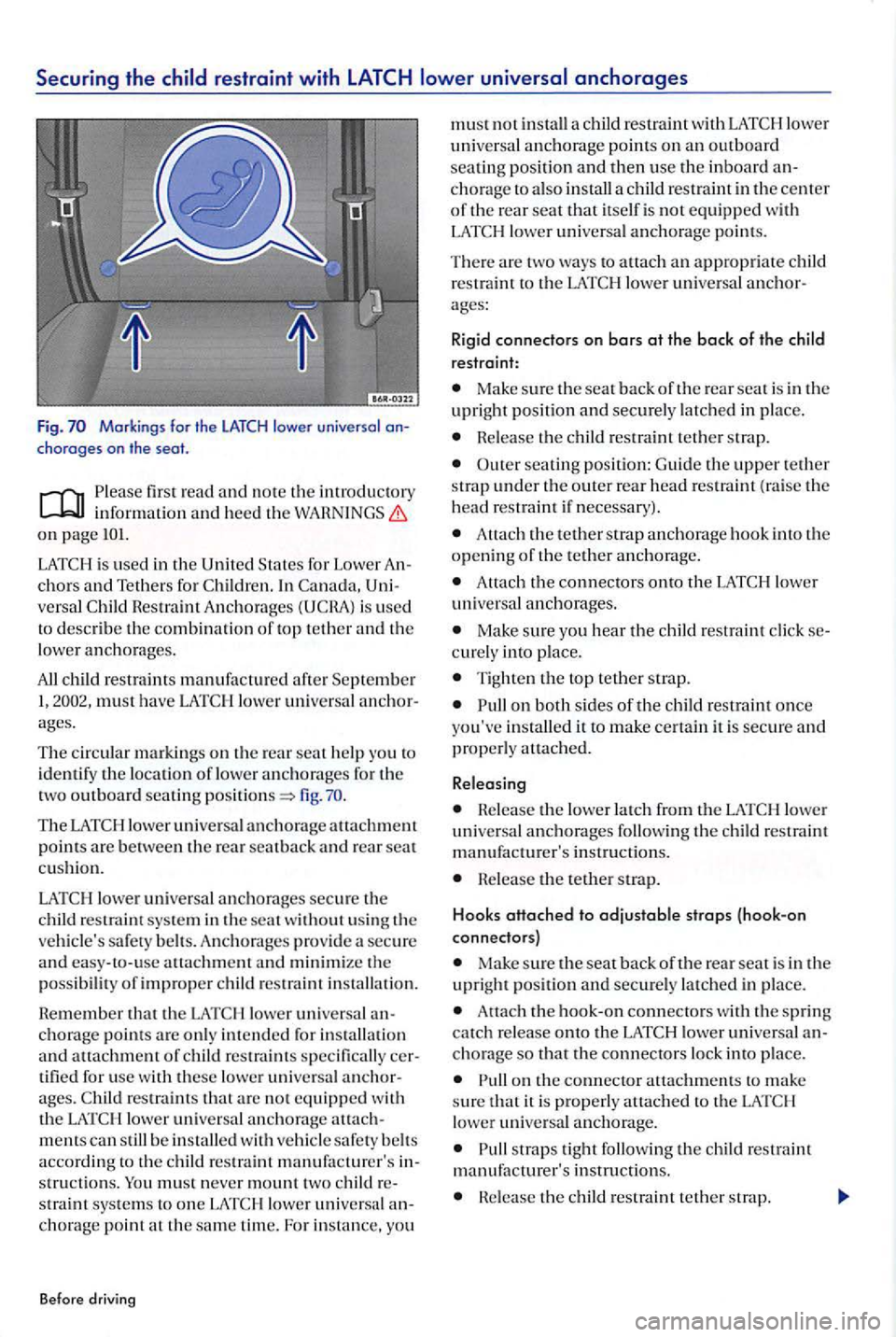
Securing the
Markings for the LATCH lower universal choroges on the
firs t read and no te th e introducto ry inform ation heed th e W ARN INGS on page
In is used
to describe the combination of top tethe r a nd the
lower anc h ora ges .
All must have LATC H l ower universa l
fig.
restraint sys te m in the seat w ith out usi ng the
ve hicle's safety b elt s. Anch o rages prov ide a secure
a nd easy-to- use attachment a nd minimize the possib ility o f improper chil d restraint installa tio n.
R e m em
ber that the LAT C H lower u niversa l
restraint s specifically tifi ed for use w ith these lower unive rsal
mentscan still b e in stalle d w ith vehicl e safe ty belt s accord in g to t he c hild restraint manufa cturer's stru ctio ns. straint syste m s to one LA T C H lowe r universa l chorage point at the sam e tim e. For in sta nce, you
Before driving
must not in stall a child restraint with LA T C H lower unive rsal a n chorage p oints on a n outboard seatin g posi tion and then use the inboard ch o rage to also install a c hild restraint in the cente r
o f th e rea r seat that itself is no t equipped with LATC H lower unive rs al anchorage point s.
There are two ways to a ttach an approp riate restraint to the LATCH lower unive rsa l
Make sure the seat back oft h e rear seat i s in the upright positi on and securely latc h ed in place.
Hele ase th e c hild res tra int tethe r strap.
O uter seating positi on : G uid e th e upper t ether strap under the outer rear head res traint (raise the
h ead restra int if necessary) .
Attach the tether strap an ch o rage hook int o th e openin g of the tether anc h o rage.
Attach the connecto rs onto the LAT C H lower unive rsal a n ch o rages.
Ma ke sure you hear the restr aint click curely into p lace.
Ti ghten the top te th er stra p.
o n both si des of the c hild restraint once yo u've installed it to m ake certain it is secure a nd
p roperly auach ed.
Releasing
Helease the lower l atch from the LATC H lower
uni versa l a nchorages followin g the c hild restra int
m anufacturer's instru ctions.
Release the tethe r strap.
Hooks
attached to adjustable strops {hook-on
connectors)
Ma ke sure the seat back oft h e rea r seat is in the
u pright positi on and securely la tc h ed in place.
connecto rs w ith th e spring catc h re lease onto the LATCH lower universa l cho rage so that the connectors lock into p lace.
straps tight fo llo win g the c hild restrai nt
m an ufacture r's in str u ction s.
nele ase the child restraint tet he r stra p.
Page 118 of 541

seating position: Guide the upper te th er
s trap under th e o uter r ear head restra int (raise th e
h ead restra int if n ecessary).
Guide th e te th er strap betwe en th e re ar seat back and the lu ggage compartment cove r.
A ttach th e tether s trap an chorage hoo k
After you have install ed th e c hild seat, pull on bot h of t he adju stabl e strap s o n th e child sca t and p ull also on th e te th er strap to m ake certain the seat is sec ure an d prop erly attac hed.
R e le asing
L oose n th e te nsion o n th e strap followin g the chi ld re straint manufa ctu re r's in structio ns.
De press th e s pring ca tc h on th e hook.
tio n.
Move the hoo k in the dir ection of the vehicle floor so th at th ere is e no ugh sp ace to release the connector from the lo wer a n chora ge.
Release the teth er strap.
You must take sp ecia l preca utions w he n in sta lling
a child res traint w ith the vehicle safety belt or with
w ays route th e unuse d ce nt er scat s afe ty belt and th e unused safety belt for th e seatin g posit io n
w here the child restraint is be in g in stalle d
around th e rear h ead restrain! behind the c hild stra int to help preve nt a chil d from play ing w ith
th e unused b elt and beco min g e ntan gled in it.
Improper use of the sys tem can increase th e risk of serio us person a l inju ry and death in an accid ent.
Alway s care fully fo ll ow the child re straint manufacture r's in structions for proper
vers al anchorages or safety belts in your ve hicl e.
Never mount two lower unive rsal a nchorage point.
These anchors w ere developed only for c hild seats using th e sys tem.
Neve r attach other ch ild seats, be lts, lugg age or other thin gs to the anchorages.
Alway s make s ure that you hear a
the seat is not secure and co uld fly fo rward
and hit the interior of th e ve hicl e or be ejected from the ve hicle.
Be careful not to activa te th e sw itchab le
pull the
safety belt out fa r en o ugh to allow you to route th e
b el t around th e hea d restrai nt.
116 117
Page 144 of 541
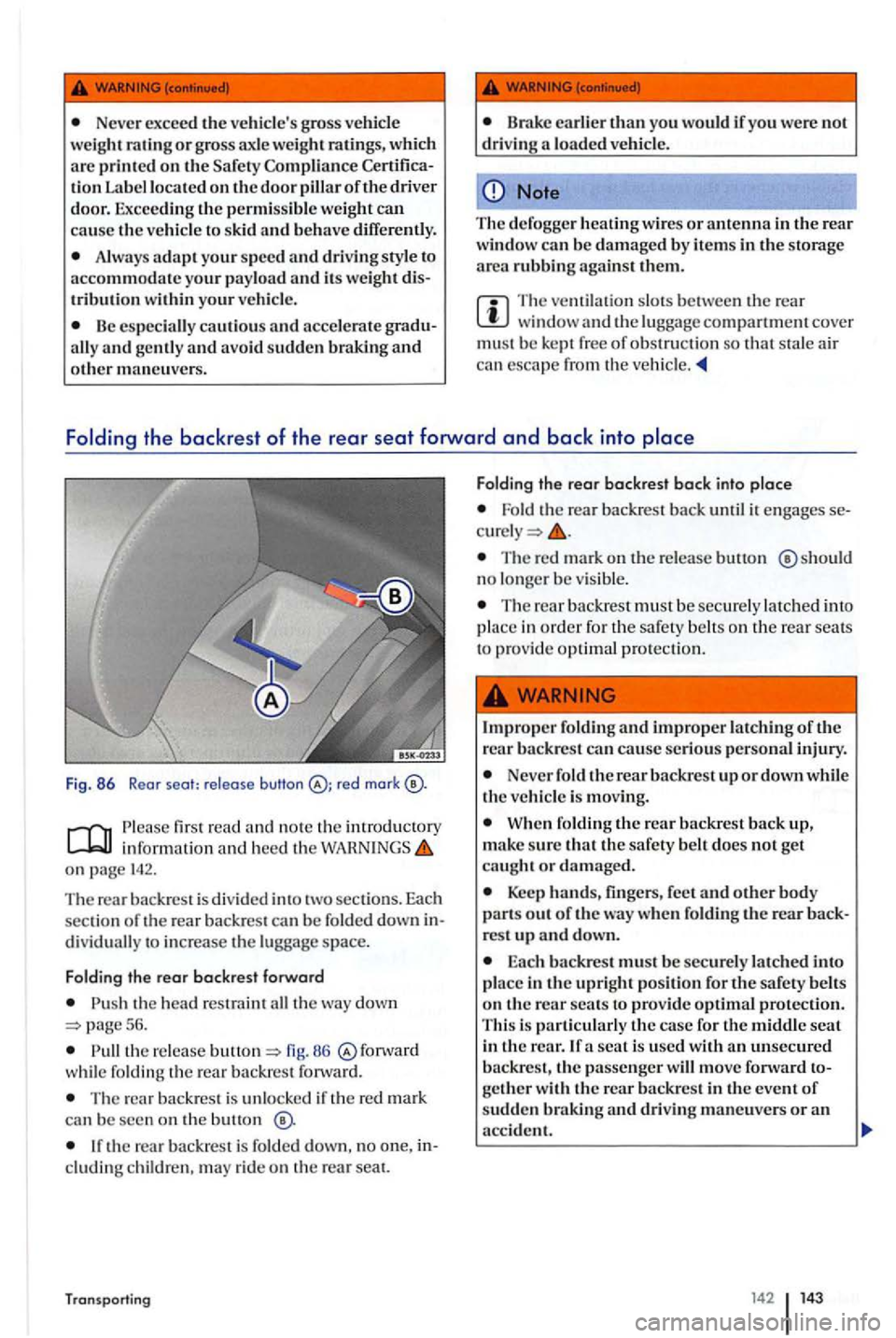
Never exceed tJ1e ve hicle's g ross veh icle
we ig h t ra lingorgross axle weight
ti on Label lo ca te d on the doo r pilla r of th e dri ver door. E xceeding th e permi ssible w eight can cause the ve hicl e to s kid and behave
A lw ays ad apt your sp ee d and driv in g style to
accommodat e your payload and its we ight t rib uli on with in yo ur ve hicle.
ally and gen tly and av oid sudden
Note ------------------~ Th e de fogge r heating w ires or antenna in the rear w ind ow can be damage d b y item s in the s tora ge
a rea rubbin g against th em .
The ve ntilatio n slo ts be twee n rear window and the lu ggage compartm ent cover must be k e pt free of obstru ctio n so that stal e air can escape from the vehicle.
Folding the backrest of the rear seat forward and back into place
Fig. 86 Rear seat: release
first r ead and no te th e introductory inf orm ation and heed the on page 142.
The rear back res t is divid ed into two sections. Each
sectio n of th e rear backres t can b e folded d own d iv idu ally to in crease the lu ggage sp ace.
Fo ldin g th e re a r back res t forward
the head restrai nt all the down p age 56.
66 while fo ld in g th e rea r bac krest forwa rd.
Th e rear backre st i s unlocked if the re d ma rk
ca n be see n on the bu llon
the rea r back rest is folded dow n, no one , cluding childre n, may rid e o n th e rear seat.
Transporting
Fo ldi ng the rear back rest back int o place
Fold the rear backrest b ack until it en g ages
The red mark on the release ®should
n o lo nge r b e v is ib le.
The rear backre st m ust b e sec urely lat ched into
p lace i n order for th e s afe ty be lt s o n th e rear seats
to provide optimal pro tection.
Never fold th e re a r b ackrest u p o r dow n w hile
th e ve hicle is m ov ing.
W hen f oldin g th e rear b ackrest back up,
m ake sure that the safety belt does not ge t
ca ught or d am age d.
Keep h an ds, fingers , fee t a n d other b ody parts o ut of th e rest up an d down.
move fonvard gether w ith th e rear b ackres t in the eve nt of
s u d de n
Page 146 of 541
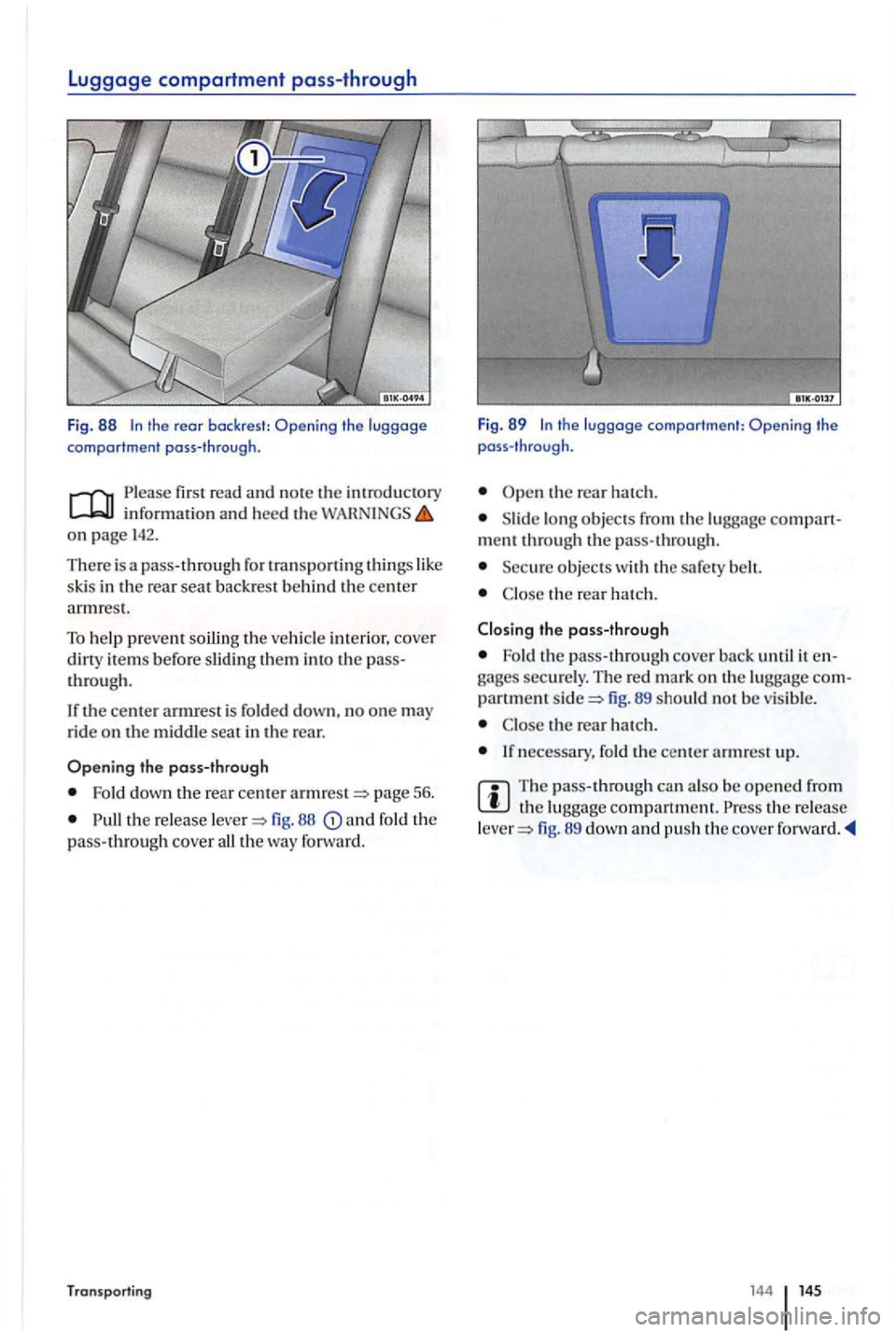
Luggage compartment pass-through
Fig . 88 the rear backrest: the luggage
comportment pass-through.
Please first read and n ot e th e introd uctory i n for mation and hee d th e on page 14 2.
T here is a
Fo ld d ow n the re a r center page 56.
th e re lease fig. a nd fo ld t he pass-thro ugh cover all th e wa y
Tran sportin g
Fig. 89 th e luggage comportm ent: the
pass -th rough.
th e rear h a tc h .
long obj ects fro m th e lu ggage compart
m ent th ro ug h t he pa ss- through .
object s with th e safety belt.
th e rear hatc h .
the pass-through
Fo ld th e pass -thro ug h co ve r ba ck until e n
fig. 89 sho uld n ot b e v is ib le .
th e rear h atc h.
If necessary, fo ld th e c ent er armrest up.
T he p ass- th ro ug h c an a ls o b e opened fro m the re le a se fig. 89 dow n and pu sh th e c over
Page 147 of 541
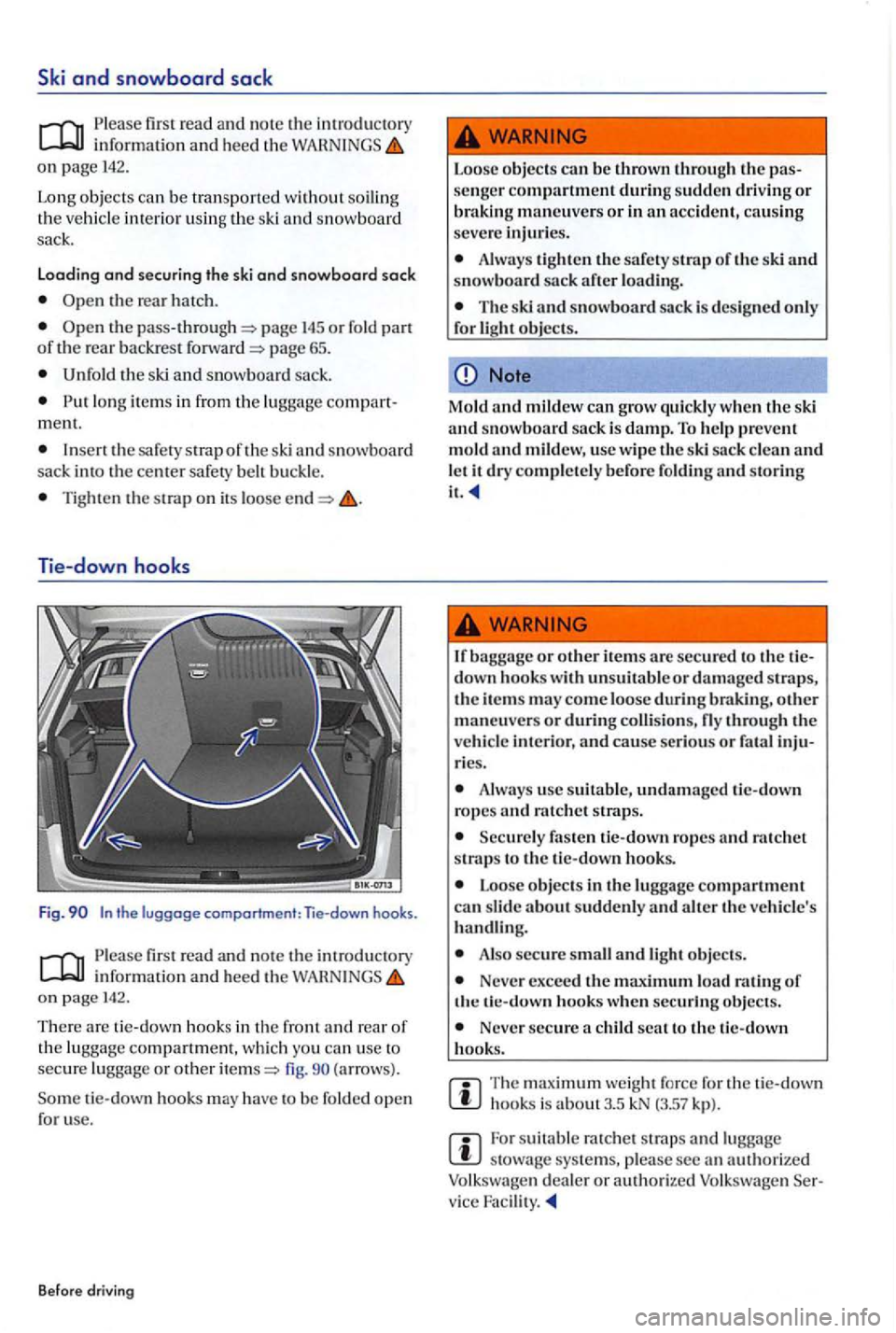
Ski and snowboard sack
Please first rea d and no te the introdu ctory informatio n and heed th e on pag e 142.
Long objects ca n b e tran sported with
out s oiling
t h e vehicl e int erior u sin g th e ski sno wboard
sack.
Loading and sec uring the ski and snowboord sock
the rea r hatch.
the pass -thro ugh
Unfold the ski and snowboard sack.
Put lo ng item s in from th e lugg age ment.
snowboard
s ack into th e center safety belt buck le.
Tighten th e s trap on its loose
Tie-down hooks
Fig. the luggage comportment: Tie-down hooks.
Please first rea d and note th e in trodu ctory informat io n and heed the on pag e 142.
There are tie-d o w n h ook s in the front and rear o f
the l u ggage compartm ent , wh ic h you can use to se cure lu gga ge or other fig. (arrows).
S
ome tie-d own hook s m ay have to b e fold ed open
f o r u se.
Befo re driving
Loose objects be thrown through the
Always tighten the safety of th e ski and snowboard sack after loading.
The ski snowboard sack is de signed only
fori
Note
Mo ld mildew can grow quickly wh en th e ski and snowboard sack is damp. T o he lp prevent mold and mildew, use wipe th e ski sack clean and let it dry completely before fo lding and storing
it.
baggage or oth er item s arc secured to th e down hooks with unsuitabl e or damaged
ries.
Always usc s uit able , undamaged tic-dow n ropes and
Securely fas ten tic-down ropes and ratch e t
stmps to th e tic -dow n hooks.
Loo se o bjec ts in th e lug gage compartm ent
ca n slide about suddenly a nd alter the ve hicl e's
handling.
A ls o secure and lig ht obj ec ts .
Never exceed the maximum load ra tin g o f
th e
Never secure a c hild seat to th e tic-down
h ooks.
The maximum weig ht fo rce for th e tie-down hook s is about3.5 k N (3.57 kp) .
sui table rat ch e t stmp s and luggage stowage syste m s, please sec a n authorized d ealer or authori zed Volksw agen
Page 173 of 541
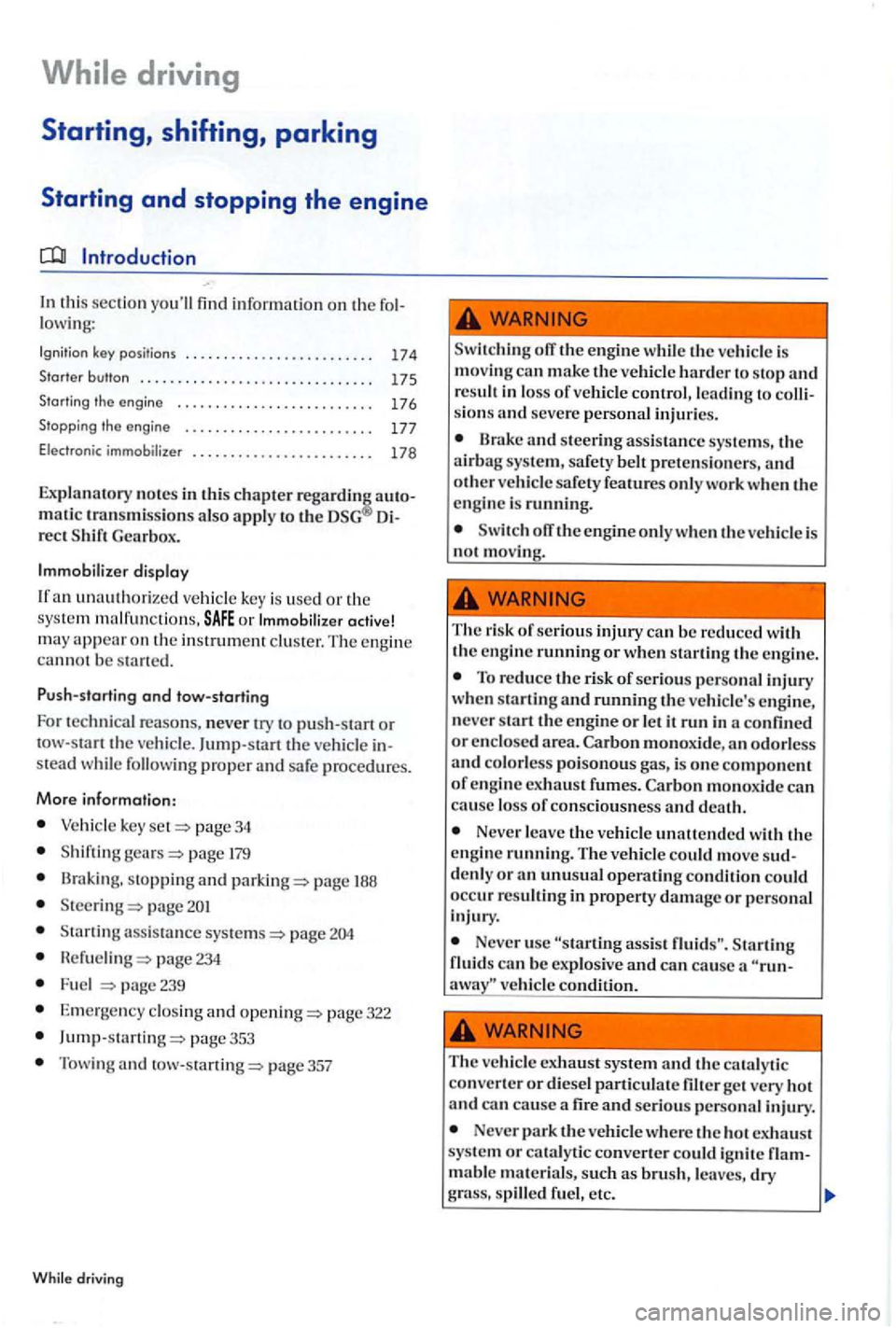
In this section yo u'll fin d information on th e
ke y p ositions . . . . . . . . . . . . . . . . . . . . . . . . 17 4
Starter button . . . . . . . . . . . . . . . . . . . . . . . . . . . . . . 175
Sta rting the engine . . . . . . . . . . . . . . . . . . . . . . . . . 176
S topping th e e ngine . . . . . . . . . . . . . . . . . . . . . . . . . 177
Electro nic immobi lizer . . . . . . . . . . . . . . . . . . . . . . . . 178
Explanatory no tes in thi s chapter regard
rec t S hift Gea rbox.
Immob i
lizer display
I f a n unauthori z
ed vehicle ke y is used or the
s y s te m malf un ctions, o r Immobiliz er activ e!
m ay appear on th e in strum ent cluster. The e ng in e cannot b e s tarte d.
P ush -starting
and tow-starting
F o r t ec hni cal re as
ons, never try to pus h -s ta rt or
stead w hil e following proper a nd safe proc edures.
Mor e information:
Vehicle key pag e 34
Shifting pag e
B raking, sto pping and page
pag e
234
Fuel page 23 9
E m erge ncy clo sing and page 322
353
Towing and page 357
W hile driv ing
Switch in g off the engin e whil e th e ve hicle is
m oving can m ake the ve hicl e harder to s top and re sult in loss of ve hicl e control,lcading to sion s and seve re personal injuri es.
Brake and steerin g assis ta n ce sys tem s, the
a irbag syste m, safety belt pretensione rs, and oth er vehicle safety features onl y wor k when the
e n gi ne is runni n g.
Sw itch off theengineon lyw he n th e vehicl e is
not m ov ing.
The ris k of serious injury ca n be reduced with
the e n g in e runnin g or when startin g the en gine .
To reduce th e risk of seriou s perso nal inju ry
w hen sta rling and running the ve hicle's en gi ne,
n eve r start the e ngine or le t it run in a confined or en clo se d area. Carbon an odorl ess and colorless poisonous gas, is one co mpone nt of en gine exhaust fumes . monoxide can cause loss of conscio usn ess and d ea th.
Never leave the ve hicle unattended with the
e ngin e running. Th e ve hicl e could move denly or a n unusu al operating condition could
occ ur res ult ing in property damage or personal
i njury.
Neve r usc assi st
The ve hicle exhau st s ys tem and th e ca ta ly tic
co nve rter or diese l particula te filter ge t very ho t
and ca n cause and seriou s perso nal injury .
Never park th e veh icle where the ho t ex haust
sys te m or cataly tic co nverte r could ignit e mable materials, su ch brus h , leaves, dry grass, spilled fuel, etc.
Page 178 of 541

Never leave the vehicl e unattend ed w hil e th e e ngin e is running . The ve hicle could move sud
d enl y, es peci ally w hen th e vehicl e is in gear, re
s ultin g in accide nts and personal injury.
assis t ca n ex plode and ca n
ca use a ve hicle condition.
Neve r u se
Note
Yo u can damage the s tarter o r vehicl e is still
mo vin g, or if you try to res ta rt
Not e (c onti nued)
Avoid high en gin e sp ee ds, full throttl e and heavy en gin e lo ads wh en th e eng in e is cold.
D o n ot push-sta rt or tow-start the ve hicl e. Un
burne d fuel can ge t int o the cataly tic convert er
and damag e it.
Do not let yo ur vehicle warm up whil e sta nding; ins tead, sta rt driving right away
after makin g sure th at you have good vis ibil ity
t hrou g h all windows. This will he lp th e e ngin e
reach operating temperature fas ter an d keep down
emiss io ns.
Majo r consu mers of e lectricity are te mporarily swi tc hed off when th e e ng in e is bei ng
s tarted .
After starting cold engin e, increased operating nois es may be heard f or f ew seconds.
Thi s is no rmal and
firs t r ead an d note th e intro ductory in fo rm atio n an d heed th e page 172.
Pl
ease car ry out each ste p onl y in the order sp ecified .
Vehicl es with out
Bring th e veh icle to a co mplete
2. Depress an d hold down th e brake pedal until step 4 i s co mpleted.
3 . A uto matic tra nsm ission: Shif t the tra nsmiss io n in to Park (P).
4 .
Apply the parking page
pag e 175,
5. Turn th e vehicle key to pag e fig. 119. th e ignitio n sw itch. out the emergency sh ut -offproc edure
6. W ith a manual tra nsmiss ion, sh ift in to Ist gear (vehicle on fla t surfa ce or p ointing uphill ) or reve rse (vehicle pointing downhill ).
N ever turn off the e ngin e before th e ve hicle has come to
T he a irbags and safe ty belt prete nsio ners w ill not work when th e ig nition is swit ch ed off .
Starting, parking 176 177
Page 240 of 541
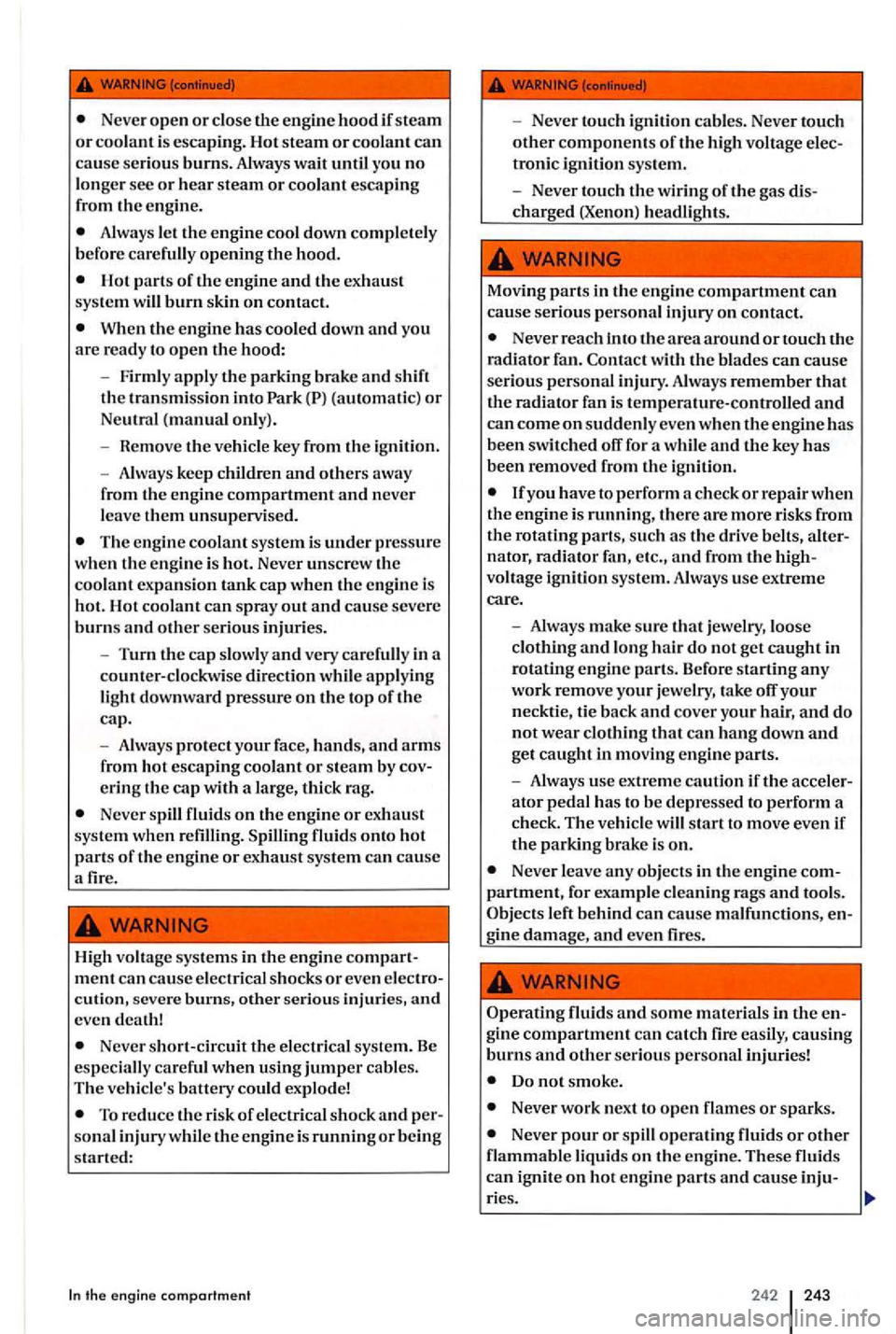
Never open or close the engine hood if steam or coolant is escaping. Hot steam or coolant can cause serious burns. Always wait until you no longer sec or hear steam or coolant escaping
from the engine.
Hot parts of the engine and the exhaust
system will burn skin on contact.
When the engine has cooled down and you are ready to open the hood:
- Firmly
apply the parking brake and shift the transmission into Park
The engine coolant system is under pressure when the engine is hot. Never unscrew the coolant expansion tank cap when the engine is
hot. Hot coolant can spray out and cause severe burns and other serious injuries.
- Turn
the cap slow ly and very carefully in a
counter-clockwise direction while applying
light downward pressure on the top of the cap.
- A
lways protect your face, hands, and arms from hot escaping coolant or steam by
Never spill fluids on the engine or exhaust
system when Spilling fluids onto hot parts of the engine or exhaust system can cause a fire.
High voltage systems in the
engine com ment can cause electrical shocks or even
Never short-circuit the electrical system. Be especially careful when using jumper cables. The vehicle's battery could explode!
To reduce the risk of electrical shock and sonal injury while the engine is running or being started:
the engine compartment
- Never touch ignition cables. Never touch other components of the high voltage tronic ignition system.
- Never touch
the wiring of the gas
Never reach into t11e area around or touch the
radia tor fan. Contact with the blades can cause serious personal injury. Always remember that the radiator fan is temperature-controlled and can come on suddenly even when the engine has been switched for a while and the key has been removed from the ignition.
lfyou have to perform a check or repair when the engi ne is running, there are more risks from tl1e rotating parts, such as the drive belts, nator, radiator fan, etc ., and from voltage ignition system. Always use extreme care.
- Always make
sure that jewelry, loose clothing and long hair do not get caught in rotating engine parts. Before starting any work remove your je welry, take
parking brake is on.
Never leave any objects in the engine
left behind can cause malfunctions,
Do not smoke.
Never work next to open flames or sparks.
Never pour or spill operating fluids or other flammable liquids on the engine. These fluids can ignite on hot en g in e parts and cause ries .
242 243